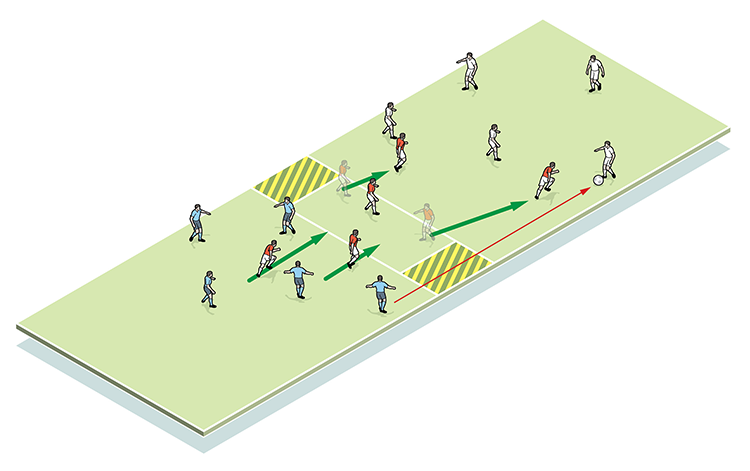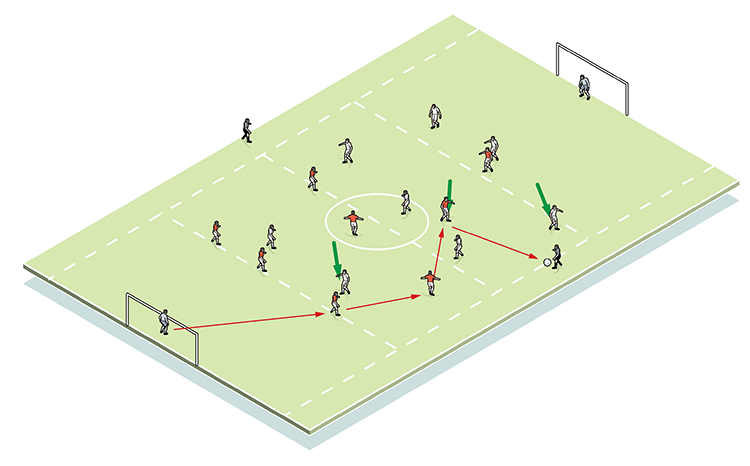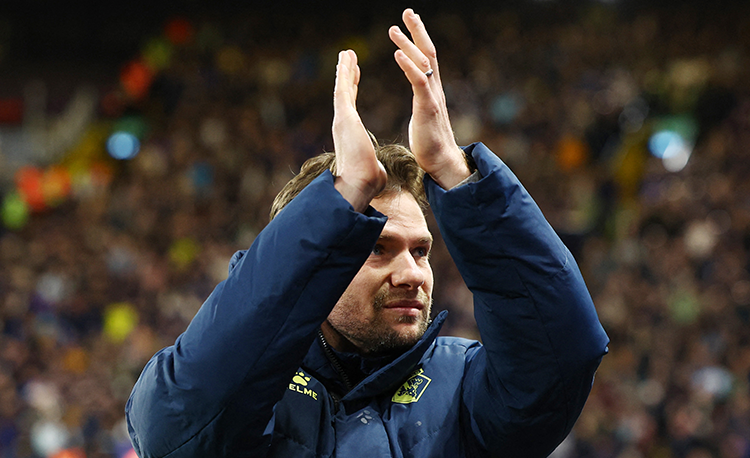Pressing and screening
Get your players pressing and screening the ball with this dynamic session. It also rehearses when and where to chase, and looks at covering positions within the team, recovery runs, and good 1v1 defending techniques.

| Area | 80x44 yards |
| Equipment | Balls, bibs, cones, goals |
| No. of Players | 17 (8v8 plus neutral) |
| Session Time | Session 20mins, Progression 20mins, Game 15mins |
This session is about pressing and screening the ball, it also rehearses when and where to chase, and looks at covering positions within the team, recovery runs, and good 1v1 defending techniques.
It’s important to practise this because it builds solid team shape, and players will understand and appreciate the need to stick to their roles. We can never over-stress to our players the importance of 1v1 defending, covering and being aware of danger.
What do I get the players to do?
We start with a possession drill in a 33x12-yard box, with a three-yard zone in the middle. On each edge of that zone lies a two-yard strip that no player can step into .
We use three teams of five players – one team in each zone. Two reds move into an end zone to chase and press the ball in a 5v2 (1a). Their opponents need to make at least three passes before transferring to the opposite box. If reds cannot screen, they must at least force blues into transferring via the unprotected channels.
1a

If the transfer is successful, chasers recover into the middle, while two new reds move to press the whites in another 5v2 (1b/1c).
1b

1c

Initially, practise this for 90-second bursts at high intensity, before rotating teams. Later on, change so that each end zone team has two lives. A life is lost if a player is tackled or a through-pass is intercepted. The first team to lose both lives becomes chasers. Play for 10 minutes.
How do I progress the session?
We move this into an 8v8 game (including keepers) in an 80x44-yard area (or the space between two penalty boxes). A neutral player in the centre always supports the attacking team. The two end boxes are 22 yards in length and offsides apply in end zones (2).
2

The aim here is that players adopt roles rehearsed in the first practise. Defenders act as screeners, staying across the width at all times. Attackers act as chasers – one presses, one drops. Midfielders, meanwhile, perform both roles, staying close together to press and screen.
Next we add a channel on each side of the pitch in which two neutral wingers work up and down, playing for the team that is in possession. (3a) When the neutral winger receives the ball high up the pitch, the nearest defender must pressurise and try to prevent the cross (3b).
3a

3b

What are the key things to look for technically/tactically?
Chasers must close down and be aware of space. They need to screen strikers, stay close together, and compact the play - effectively ‘mirroring’ the ball. Defenders need to adjust quickly to stop crosses, block shots and delay attacks.
Editor's Picks
Attacking transitions
Deep runs in the final third
Using the goalkeeper in build-up play
Intensive boxes drill with goals
Penetrating the final third
Creating and finishing
My philosophy
Pressing initiation
Compact team movement
Coaches' Testimonials

Alan Pardew

Arsène Wenger

Brendan Rodgers

Carlos Carvalhal

José Mourinho

Jürgen Klopp

Pep Guardiola

Roy Hodgson

Sir Alex Ferguson

Steven Gerrard
Coaches' Testimonials

Gerald Kearney, Downtown Las Vegas Soccer Club

Paul Butler, Florida, USA

Rick Shields, Springboro, USA

Tony Green, Pierrefonds Titans, Quebec, Canada
Join the world's leading coaches and managers and discover for yourself one of the best kept secrets in coaching. No other training tool on the planet is written or read by the calibre of names you’ll find in Elite Soccer.
In a recent survey 92% of subscribers said Elite Soccer makes them more confident, 89% said it makes them a more effective coach and 91% said it makes them more inspired.
Get Monthly Inspiration
All the latest techniques and approaches
Since 2010 Elite Soccer has given subscribers exclusive insight into the training ground practices of the world’s best coaches. Published in partnership with the League Managers Association we have unparalleled access to the leading lights in the English leagues, as well as a host of international managers.
Elite Soccer exclusively features sessions written by the coaches themselves. There are no observed sessions and no sessions “in the style of”, just first-hand advice delivered direct to you from the coach.









